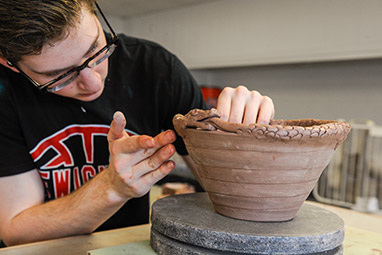SPARTANBURG, S.C. — Spending much of her time either on the soccer field or in training, Mayson Liner used this past January to return to one of her passions: art. An English major with a film and digital media concentration from Athens, Tenn., Liner took visual art courses throughout high school but hasn't had time in college — that is, until she took the “Functional Beauty: The Art and Craft of Pottery” course for Interim.
Led by Dr. Natalie Grinnell, professor of English, the course teaches the history and cultural significance of pottery through visits to arts centers and guest speakers. It also focuses on the hands-on creative process of hand-building and wheel-throwing pottery.
“It’s rewarding to see that there are wonderfully creative students who didn’t previously know their talents as an artist,” says Grinnell. “They got to express themselves in ways they may not have previously expected.”
The class also relied on the service of Ann Gleason, an adjunct art and art history professor, who acted as the artist-in-residence over the course of the month. Gleason taught hand-building techniques, moving to pinch pots and slab building before working one-on-one with students at the wheel.
Liner did mostly hand-building, creating bowls and mugs. She even went so far as to make an elephant figurine.
“The Interim itself was about trying new things. Pottery allows us to be a part of what we do,” says Liner.
Grinnell worked every day alongside the class, enjoying the meditative process of working with the clay.
“Working with clay to make pottery is a new way of learning, thinking and visualizing the world through the lens of texture and of aesthetics,” says Grinnell. “And it’s different — you can’t be good at it through force of will, you have to work and practice at it, but even if the pot doesn’t come out, the process of working with the clay is the experience.”
Liner says the experience of learning about and creating pottery made her more appreciative of art. “Visual art is one of the most important things in life because almost everything we use, consume and receive now is through the visual aesthetic whether it be TV, literature and social media,” she says. “It’s important that we not only see these visual things, but also see how they were made and built, how they're used in society and how they affects those who use them.”
by Kelsey Aylor, Wofford Class of 2018
The wheels are turning
Wofford offers students the opportunity to delve into the art of pottery